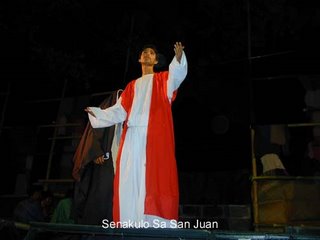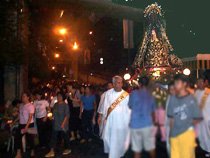I'd like to share the same content here in my blog, so here it goes...
Easter Sunday is only one day compared to the "Semana Santa" (or Holy Week) or “Cuaresma” which is what we call The Week being the significant culmination of our faith as Catholic Filipinos during the Lenten Season.
 All over the Philippines, we begin our celebrations with Palm Sunday, which we call “Palaspas”. People bring coconut palm leaves to church – usually converted into very creative designs – to re-enact Jesus’ triumphant entry into Jerusalem. These are then blessed by the priest and kept in everyone’s homes and acts as protection for those homes as well as an object that wards off evil spirits.
All over the Philippines, we begin our celebrations with Palm Sunday, which we call “Palaspas”. People bring coconut palm leaves to church – usually converted into very creative designs – to re-enact Jesus’ triumphant entry into Jerusalem. These are then blessed by the priest and kept in everyone’s homes and acts as protection for those homes as well as an object that wards off evil spirits. Onwards from this day, people begin to be more somber in mood and deeds, recollecting Christ’s passion and reflecting on how their lives have been for the past year, similar to what some would do during the New Year’s Eve but with more focus on being a person of faith.
Many would practice fasting or giving up of daily indulgences locally called “indolehencia” where for example, if normally you would ride to work in your car; for this week you may consider taking the public transport, at the least, or; if you normally indulge in eating chocolates, you may want to refrain from the habit this week. Other “more difficult” forms are fasting for the entire week, taking only water; refraining from “acts of the flesh”; keeping a vow of silence; and many more. The bottom line is, you make a sacrifice or you give up a worldly pleasure as a way of internalizing your faith and walking in Jesus’ footsteps.
The week also begins the daily “pabasa” or reading of the “Pasyon”. This is based on a book of text originally attributed to Gaspar Aguinaldo de Belen who wrote “Ang Mahal na Passion ni Jesu Christong Panginoon Natin sa Tola” (The Holy Passion of Jesus Christ our Lord in Poetry) published in the early 1700s.
 The “Pasyon” is read the whole day from as early as 6:00 am until about 10:00 pm. Most communities would have professional “Pasyon” readers who have made it their life’s pledge to read the “Pasyon” during Holy Week and pass on the responsibility and the privilege to the next generation. It begins with readings from the Old Testament and focuses on Christ’s suffering, death and resurrection in the New Testament. Huge crowds usually gather round the reader to listen and reflect on the words.
The “Pasyon” is read the whole day from as early as 6:00 am until about 10:00 pm. Most communities would have professional “Pasyon” readers who have made it their life’s pledge to read the “Pasyon” during Holy Week and pass on the responsibility and the privilege to the next generation. It begins with readings from the Old Testament and focuses on Christ’s suffering, death and resurrection in the New Testament. Huge crowds usually gather round the reader to listen and reflect on the words. The narrative poem is read in a distinct way as each paragraph is 5 lines long and one line has 8 syllables each, giving it a chant-like tune that only seasoned readers know how to articulate. Often the reader, feeling the gravity of Christ’s suffering, would himself or herself be affected to tears. Sometimes, readers would be given access to microphones or megaphones that would project their voices loud enough to be heard through several homes in a neighborhood. Since people are encouraged to be solemn and practice silence, the “pabasa” would float over the community not unlike the call of prayers from the mosque.
As the Pasyon’s “kubol” (tent) us being built so too is a stage for the week’s “Senakulo.” This religious play is spoken in verse giving the lines of each actor a poetic sing-song lilt that is amusing to the audience. The senakulo runs for each night of the Holy Week from Palm Sunday through to Easter Sunday. The theme is always about the life and suffering of Jesus Christ focusing on his final days as a mortal but several senakulo’s by tradition also reflect Philippine socio-political events and may have an underlying political message throughout the plays. Children and adults alike enjoy the senakulo where actors where colorful costumes and add their own personal interpretation to the characters.
 |  |
Serious fasting and self denial intensifies on Maundy Thursday. Here people take time to be with their families and go to church to remember “The Way of the Cross” – Jesus capture, condemnation, suffering and crucifixion. Eating meat is avoided and people stick to traditional fares of bico (rice cakes), guinatan (sweet yam, glutinuous rice, ube and banana cooked in coconut milk), puto (another version of rice cakes) or just plain bread.
On Good Friday, many would either be in church or stay at home with their families and watch religious programs like “The Ten Commandments” or “Jesus of Nazareth” and continue to be penitent. Several towns gather to witness men and a few women who voluntarily whip themselves while in procession in the streets to the town center where some of them would be nailed and crucified like Jesus. This is the consummate penitentia, being able to walk the path of sorrow and suffering like Jesus did. This has received mixed reviews from many tourists who come to the Philippines to witness this but for the people who actually do the Penitentia, they are more concerned with their internal struggle to be like Christ even to be crucified like Him. Some have even done the Penitentia more than once and has become an annual ritual of self-denial, sacrifice and spiritual rebirth. Many Filipinos opt not to bathe on Good Friday given that Christ died on this day. Also on this day, the parish priest of each community would select several community members to act as the apostles. He would then proceed to wash these men’s feet and anoint them with oil as Christ did to his own twelve apostles.
 |  |  |
Black Saturday is marked by the Visita Iglesia. Families would visit the “holy bier” of Jesus in as many churches as they can afford to visit. In our family, we try to visit thirteen churches on this day within Metro Manila. Famous stops are the Baclaran, Quiapo and Intramuros churches in the Manila area, others would be churches meaningful to our family like our parish church, the parish church where we went to school, St. Anthony in Singalong; the church where my parents got married, Pope Pious near Luneta, added to the rest that are accessible or en route to family and friends homes because visiting relatives and friends is one of the do-ables in Filipino Holy Week. A recent addition to our “to be visited” list is my husband’s parish church, Holy Family in Roxas District, Quezon City and the church where we got married, Our Lady of the Airways in Paranaque, near the International Airport.
It is actually on Black Saturday that people, who did not bathe on Good Friday, take a communal bath either in the rivers and seas all over the Philippines or in their homes. Many believe that if you jumped up and down on Black Saturday, you would likely grow taller in the year. From 10:00 pm, people may take meat especially young children and not doing so may cause you to suffer from an illness within the year.
In the evening, many people would be in their parish church to pray and hold a vigil. The Rosary would be prayed continuously as people remember Mary, Christ’s mother in her most trying times. The mass at midnight begins with all the lights turned off and a candle held by each attendee is lighted until the whole congregation is bright from all the burning candles.
 |  |
At dawn, we have the Salubong where a procession carrying the image of Mary meets a separate procession carrying the image of the Risen Lord Jesus. This is followed by mass where people renew their faith as was recited to them during their Baptism. At home, families gather together in what would be similar to a Christmas feast and would indulge children to Easter egg hunts as well as sweets and even presents.
 |  |
Concurrently in Marinduque, one of the cities in the Philippines (located in a separate island), celebrates the Moriones Festival on Easter Sunday. This is a colorful mardi gras that follows the life of a Roman Legionnaire, Longinus, who became a Christian convert during Christ’s “way of the cross” and crucifixion. Performers dance and act in the streets and are dressed as Romans wearing toga and the legionnaire’s outfits all wearing colorful masks. It ends when Longinus is captured and beheaded for his faith.

======
As you can see, Filipinos do not just bathe in the polluted waters of Manila Bay. They relive the joys and sufferings of the Christ Jesus through a whole week of reflection, worship and self denial culminating in a meaningful reaffirmation of faith and joyful celebrations.
Belated Happy Easter to all.
1 comment:
cuaresma is the 40 day preparation, holy week is a part of cuaresma. It starts on ash wednesday :)
Post a Comment